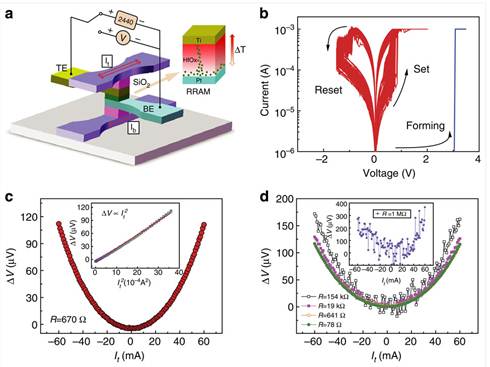Recently, researchers from Lab of Nano-fabrication and Novel Devices Integration in Institute of Microelectronics of Chinese Academy of Sciences (IMECAS) have made important progress in electronic transport mechanism in resistance random access memory (RRAM).
RRAM is one of the most promising candidates for the next-generation nonvolatile memory due to its simple structure, high operation speed, low power consumption and feasibility of three-dimensional (3D) stack. It is believed that the formation (low resistance state)/rupture (high resistance state) of local conductive paths is responsible for resistive switching process. Understanding electronic transport mechanism in the formed conductive paths is vital to control and improve memory performance and establish a basic framework for modeling resistive switching behavior. However, as a fundamental question, how electron transports in the formed conductive paths is still under debate due to the difficulty to directly characterize its physical and electrical properties. In current research area, one of the urgent problems to be studied and settled is how to exactly measure electronic transport process in conductive paths.
Liu’s group from Lab of Nano-fabrication and Novel Devices Integration in IMECAS has made a series of progress in research on resistive switching mechanism in RRAM. In 2012, this research group observed dynamic growth/dissolution of conductive paths in oxide-electrolyte-based RRAM by using the in-situ TEM technology (published on Adv. Mater., 24, 1844, 2012). Subsequently, they performed a novel research on thermoelectric Seebeck effect in oxide-based RRAM to explore the electronic transport mechanism in conductive paths for the first time. Seebeck effect, a typical thermoelectric phenomenon that directly converts the temperature difference to electric field, can provide deeper insights into the energetics of dominant charge transport process, due that it could effectively exclude interfacial contact effect (Seebeck measurement schematic and results shown in Figure). Compared to the uncertainty of metallic and non-metallic behaviors of conductive paths in the previous reports, Seebeck measurement results demonstrated that there only existed non-metallic conductive paths in oxide-based RRAM, and electronic transport process for all resistance states could be attributed to the small-polaron hopping model. Moreover, they proposed an approach to calculate carrier concentration in conductive paths and the calculation results confirmed the carrier concentration (~1021cm-3) in conductive paths below the critical value of metal (~1022 cm-3). This work provides a novel approach to investigate resistive switching mechanism and clarity the electronic transport process in conductive paths in oxide-based RRAM. It was published on Nature Communications journal in August, 2014(DOI: 10.1038/ncomms5598).
This work was supported by Science Fund for Creative Research Groups of the National Natural Science Foundation of China, National Basic Research Program of China (973 Program) and National High Technology Research and Development Program of China (863 Program).

Link:http://www.nature.com/ncomms/2014/140820/ncomms5598/full/ncomms5598.html?WT.ec_id=NCOMMS-20140827











